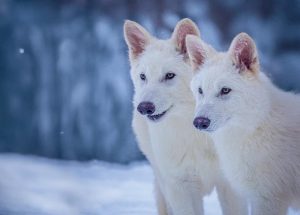
The biotech company that aims to perform a Jurassic Park-like resurrection of the woolly mammoth has announced that they have re-created the previously-extinct dire wolf, in what the company is calling the world’s first “de-extinction” of a species that disappeared nearly 10,000 years ago. Although the animals are being presented as dire wolves, the claim is being disputed by paleogenetics experts, due to the pups being genetically-tweaked gray wolves, with no dire wolf DNA being involved in their genetic makeup.
As part of their attempt to re-populate the Siberian tundra with animals that went extinct at the end of the Pleistocene era in an effort to fight climate change,—cheifly the woolly mammoth—Colossal Biosciences has produced three wolf pups that have been genetically altered to mimic the physical traits that differentiate the long-extinct dire wolf (Aenocyon dirus) from wolf species that are present today.
After studying genetic samples harvested from a 13,000-year-old tooth and a 72,000-year-old ear bone from dire wolf fossils, Colossal’s researchers modified 14 key genes in modern gray wolf (Canis lupus) endothelial progenitor cells (EPC) so that they would express 20 traits known to be unique to dire wolves, meaning that “no ancient dire wolf DNA was actually spliced into the gray wolf’s genome,” according to an April 7 Time Magazine article.
This process produced two pups, who were born on October 1, 2024; they were named Romulus and Remus after the legendary twin brothers that founded the city of Rome, who were nursed by a she-wolf. On January 30 the following year, they were joined by a sister, Khaleesi, named after the title of the fictional character Daenerys Targaryen from Game of Thrones, the plot of which features creatures based on real-life dire wolves.
Romulus, Remus and Khaleesi are being raised in an undisclosed 2,000-acre (810 hectare) ecological preserve, and are monitored with 24-hour veterinary supervision. Although they have not been taught to hunt, they are provided with beef, deer and horse meat, along with organ meats.
So far, their behavior has been consistent with that of modern wolves, shying away from humans, including their handlers. Having reached nearly four feet (122 centimeters) long by the time they were six months old, the males are expected to reach six feet (183 centimeters) in length when fully grown. They also sport white fur, a genetic tweak made by Colossal in the belief that ancient dire wolves would have had the same coloration.
But the claim that Romulus, Remus and Khaleesi are dire wolves is being disputed by experts on the matter, since their genetic makeup contains no dire wolf DNA: Jeremy Austin, the Director of the Australian Centre for Ancient DNA, stated that “a lot of scientists are going to be scratching their heads, saying, ‘Look, you’ve got a white, gray wolf.’ That’s not a dire wolf under any definition of a species ever… I don’t think that this represents de-extinction in any way, shape, or form.”
This sentiment was echoed by Otago University paleontologist Dr. Nic Rawlence, who pointed out that with only a small number of edits to their genes, Romulus, Remus and Khaleesi are more closely related to gray wolves than dire wolves, who, despite their physical similarities, are no more related to modern wolves than they are foxes: dire wolves are not only a different species, but are part of a different taxonomic genus altogether (Aenocyon rather than Canis), that appear to have diverged from their last common ancestor about 5.7 million years ago.
It is uncertain as to what the future holds for Romulus, Remus and Khaleesi: setting aside the fact that dire wolves were unique to North America, releasing them or their progeny in the Siberian north appears to be unlikely given the current political climate; and since dire wolves have no ecological niche to claim in the modern world, they may be relegated to being zoo animals.
However, the Mandan, Hidatsa, and Arikara Nation tribes have expressed an interest in having Colossal’s wolves join the wildlife that inhabits the one million acre (400,000 hectare) Fort Berthold Reservation in North Dakota—a proposal that Colossal is considering.
Subscribers, to watch the subscriber version of the video, first log in then click on Dreamland Subscriber-Only Video Podcast link.